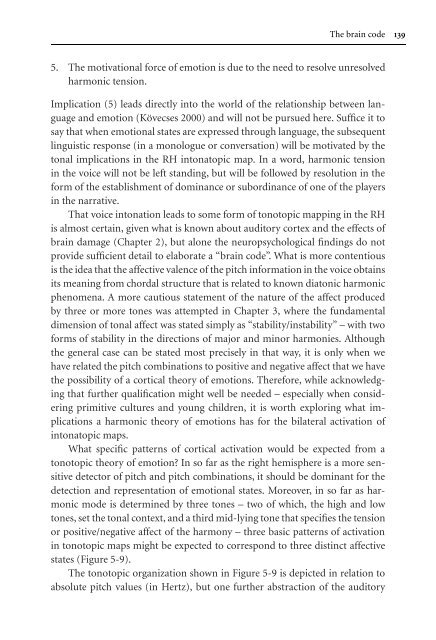Tone of Voice and Mind : The Connections between Intonation ...
Tone of Voice and Mind : The Connections between Intonation ...
Tone of Voice and Mind : The Connections between Intonation ...
You also want an ePaper? Increase the reach of your titles
YUMPU automatically turns print PDFs into web optimized ePapers that Google loves.
<strong>The</strong> brain code 139<br />
5. <strong>The</strong> motivational force <strong>of</strong> emotion is due to the need to resolve unresolved<br />
harmonic tension.<br />
Implication (5) leads directly into the world <strong>of</strong> the relationship <strong>between</strong> language<br />
<strong>and</strong> emotion (Kövecses 2000) <strong>and</strong> will not be pursued here. Suffice it to<br />
say that when emotional states are expressed through language, the subsequent<br />
linguistic response (in a monologue or conversation) will be motivated by the<br />
tonal implications in the RH intonatopic map. In a word, harmonic tension<br />
in the voice will not be left st<strong>and</strong>ing, but will be followed by resolution in the<br />
form <strong>of</strong> the establishment <strong>of</strong> dominance or subordinance <strong>of</strong> one <strong>of</strong> the players<br />
in the narrative.<br />
That voice intonation leads to some form <strong>of</strong> tonotopic mapping in the RH<br />
is almost certain, given what is known about auditory cortex <strong>and</strong> the effects <strong>of</strong><br />
brain damage (Chapter 2), but alone the neuropsychological findings do not<br />
provide sufficient detail to elaborate a “brain code”. What is more contentious<br />
is the idea that the affective valence <strong>of</strong> the pitch information in the voice obtains<br />
its meaning from chordal structure that is related to known diatonic harmonic<br />
phenomena. A more cautious statement <strong>of</strong> the nature <strong>of</strong> the affect produced<br />
by three or more tones was attempted in Chapter 3, where the fundamental<br />
dimension <strong>of</strong> tonal affect was stated simply as “stability/instability”–with two<br />
forms <strong>of</strong> stability in the directions <strong>of</strong> major <strong>and</strong> minor harmonies. Although<br />
the general case can be stated most precisely in that way, it is only when we<br />
have related the pitch combinations to positive <strong>and</strong> negative affect that we have<br />
the possibility <strong>of</strong> a cortical theory <strong>of</strong> emotions. <strong>The</strong>refore, while acknowledging<br />
that further qualification might well be needed – especially when considering<br />
primitive cultures <strong>and</strong> young children, it is worth exploring what implications<br />
a harmonic theory <strong>of</strong> emotions has for the bilateral activation <strong>of</strong><br />
intonatopic maps.<br />
What specific patterns <strong>of</strong> cortical activation would be expected from a<br />
tonotopic theory <strong>of</strong> emotion? In so far as the right hemisphere is a more sensitive<br />
detector <strong>of</strong> pitch <strong>and</strong> pitch combinations, it should be dominant for the<br />
detection <strong>and</strong> representation <strong>of</strong> emotional states. Moreover, in so far as harmonic<br />
mode is determined by three tones – two <strong>of</strong> which, the high <strong>and</strong> low<br />
tones, set the tonal context, <strong>and</strong> a third mid-lying tone that specifies the tension<br />
or positive/negative affect <strong>of</strong> the harmony – three basic patterns <strong>of</strong> activation<br />
in tonotopic maps might be expected to correspond to three distinct affective<br />
states (Figure 5-9).<br />
<strong>The</strong> tonotopic organization shown in Figure 5-9 is depicted in relation to<br />
absolute pitch values (in Hertz), but one further abstraction <strong>of</strong> the auditory


